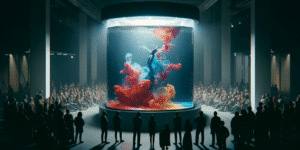Performance art, by its very nature, pushes boundaries. It thrives on experimentation, challenging traditional notions of art and audience interaction. But where exactly do artists draw the line? Can the pursuit of artistic expression ever justify causing harm, either physical or emotional, to the performer or the audience? This question lies at the heart of the ongoing debate surrounding the ethics of performance art.
While captivating audiences with its rawness and immediacy, performance art can also be a confronting experience. From Marina Abramović’s endurance pieces that test the limits of the human body to socially charged works that tackle sensitive themes, performance art often walks a tightrope between provocation and transgression. Understanding where artists draw the line, and the considerations they make, is crucial to appreciating this complex art form.
Read also: Embracing Simplicity: The Art of Natural Makeup
Exploring Boundaries in Performance Art
Performance art thrives on challenging conventions. It’s a space where artists push the boundaries of self-expression, audience interaction, and the very definition of art itself. But with this freedom comes a crucial question: where do artists draw the line? This exploration delves into the ethical considerations that performance artists navigate, focusing on the potential for harm, audience participation, and the delicate balance between provocation and offense.
Ethical Considerations: Balancing Act Between Artist and Audience
Central to the debate is the potential for harm, both to the artist and the audience. Physical harm can occur in endurance-based pieces, where artists test their bodies to the limit. Marina Abramović’s “Rhythm 0” (1974), where she allowed the audience to interact with her for six hours using various objects, raises questions about exploitation and the artist’s vulnerability.
Psychological harm is another concern. Performances dealing with sensitive themes or trauma can be emotionally unsettling for viewers. A key ethical consideration is to balance artistic expression and potential audience distress.
Consent and the Role of the Audience
Audience participation is a defining element of performance art, but the level of interaction can vary greatly. Informed consent becomes paramount when participation is expected. Conversely, unexpected audience involvement raises questions about boundaries and comfort. The influential performance group, The Living Theatre, often blurred the lines between performer and audience, creating a dynamic where viewers could become unwilling participants.
Shock vs. Offense: The Tightrope Walk of Provocation
Performance art often employs shock tactics to provoke thought and discussion. However, there’s a fine line between pushing boundaries and causing undue offense. Chris Burden’s controversial performance “Shoot” (1971), where he had himself shot in the arm, sparked outrage and debate about the role of violence in art. Artists must consider the intent behind provocation: is it meant to spark meaningful dialogue or simply shock for the sake of it?
Ultimately, the role of the audience is crucial in defining these boundaries. Audience expectations, cultural background, and personal sensitivities all play a part in how a performance is perceived. A line of nudity that might be considered commonplace in one culture could be deeply offensive in another.
The exploration of boundaries in performance art is an ongoing conversation. By acknowledging the ethical considerations, the role of audience participation, and the power of provocation, we can develop a richer understanding of this ever-evolving art form.
Context and Controversy in Performance Art
Performance art’s history is rich with controversy, pushing boundaries and sparking debates about artistic expression. Examining past controversies and cultural perspectives helps us understand where artists draw the line in different contexts.
Famous Controversies: Turning Points and the Evolution of the Art Form
Landmark controversies like Karen Finley’s performances in the 1990s, which incorporated graphic imagery and challenged societal norms, ignited discussions about censorship and the limits of free expression in art. These events became turning points, forcing audiences and institutions to grapple with the role and responsibility of performance art.
Understanding historical examples, like Chris Burden’s “Shoot” (1971), where the artist was shot in the arm, allows us to see how boundaries have shifted over time. What was once considered shocking might now be viewed as historically significant. These controversies have both challenged and shaped the identity of performance art itself.
Cultural Perspectives: Navigating Boundaries Across Societies
The boundaries of what is considered acceptable in performance art vary greatly across cultures. Concepts of nudity, violence, and religious themes can be interpreted very differently. For example, body exposure in a Western performance might be considered offensive, while it could hold a different meaning entirely in a ritualistic context.
This raises the question: is there a universal line, or are boundaries entirely culturally specific? Understanding the cultural context of a performance is crucial for appreciating the artist’s intent and the audience’s potential reaction.
Universality vs. Cultural Specificity: Finding the Balance
While some argue for a universal standard of acceptability in art, others believe boundaries are inherently shaped by cultural norms. Perhaps the answer lies somewhere in between. There might be some fundamental ethical principles, such as avoiding gratuitous violence or exploitation, that hold some degree of universality. However, acknowledging the influence of culture and allowing for flexibility is also important.
Examining both historical controversies and the influence of cultural perspectives on boundaries in performance art sheds light on the ongoing negotiation between artistic freedom and social responsibility. This complex dance is what makes performance art such a powerful and thought-provoking medium.

The Body, Improvisation, and Documentation in Performance Art
Performance art pushes boundaries by its very nature. But how does the artist navigate these boundaries, particularly when the body itself becomes the medium of expression? This exploration delves into the artist’s body, improvisation, and documentation, all of which influence where lines are drawn in performance art.
The Artist’s Body: A Canvas with Risks
The human body is a central element in many performance pieces. This can blur the lines between artistic exploration and physical risk. For instance, some artists use endurance-based performances, pushing their bodies to the limit. This raises ethical questions about the performer’s vulnerability and the potential for self-harm. Artists like Ron Athey, known for his confrontational performances that explore themes of pain and mortality, exemplify this approach.
Improvisation: Embracing the Unknown and Defining Boundaries in Real-Time
Many performance art pieces incorporate improvisation, where the unplanned nature of the act can push boundaries in unexpected ways. Audience reactions and chance encounters become integral parts of the performance.
Stelarc, an Australian performance artist known for using his body as a canvas for suspensions and other interventions, often incorporates improvisation into his work, blurring the lines between performer and audience participation. These unscripted moments raise questions about how boundaries are defined in such a fluid context.
Documentation: Capturing the Fleeting and Shaping Perception
Performance art is inherently ephemeral, existing only in the moment. Documentation, through photographs, videos, or written descriptions, attempts to capture this experience. However, documenting a performance can also influence how it is perceived. A static image might not convey the full intensity or emotional impact of the live performance.
The decision to document a performance, and how it is documented, shapes the audience’s understanding. For instance, a heavily edited video might present a very different experience compared to the raw, unfiltered reality of the live performance. The artist must consider the potential impact of documentation on the overall message and impact of the piece.
Ephemeral vs. Documented Performance: Balancing Liveness and Legacy
The tension between the fleeting nature of live performance and the permanence of documentation is a hallmark of performance art. While documentation offers the opportunity to share the experience with a wider audience, it can also alter the essence of the live performance.
Ultimately, the artist must decide how much control they want to exert over the perception of their work. Do they embrace the ephemeral nature of the live experience, or do they seek to create a more permanent record through documentation?
Understanding the interplay between the artist’s body, improvisation, and documentation helps us appreciate the complexities of defining boundaries in performance art. These elements work together to create a unique and ever-evolving art form that challenges both the artist and the audience.
Read also: The Artistry of Facial Expressions: Mastering the Craft in Photoshoots
A Balancing Act in a Dynamic Art Form
Performance art thrives on pushing boundaries, but this freedom comes with a responsibility to navigate complex ethical considerations. The artist must balance the potential for harm, both physical and psychological, to themself and the audience. Informed consent and clear expectations around participation are crucial, especially when audience interaction is a key element.
The line between provocation and offense is a tightrope walk. While shocking tactics can spark important conversations, artists must consider the intent behind their work. Ultimately, the audience plays a significant role in defining boundaries through their expectations, cultural background, and personal sensitivities.
Examining historical controversies and cultural perspectives on boundaries reveals that what is considered acceptable can vary greatly. There might be some universal ethical principles, but acknowledging cultural context is essential. This ongoing negotiation between artistic freedom and social responsibility is what makes performance art such a powerful and thought-provoking medium.








